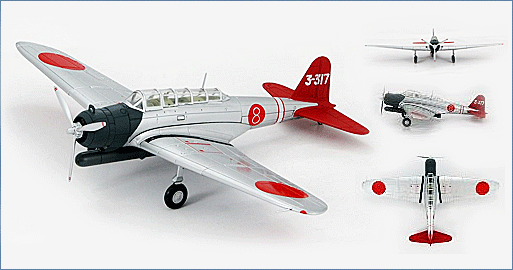Air Power Series>1:72 die-cast display model>Kate>HA2004
Nakajima B5N2 "Kate" Naval 12th Flying Group, China 1940-1941

General Background
When Japan entered WWII the B5N Kate was the standard torpedo bomber and sank more Allied ships than any other type of Japanese aircraft. B5N2's played the main role in sinking the carrier Lexington at Coral Sea,Yorktown at Midway and Hornet at the Battle of Santa Cruz in October 1942. There were 1,150 B5N1 and B5N2 Torpedo Bombers produced but by 1944 the Kate had been replaced by the B6N "Jill". The Kate ended its service being used for Kamikaze attacks leaving no surviving examples.
The Aircraft
The B5N1 entered service in 1937 and served as a tactical bomber in the attack of China. In 1939 it was replaced by the B5N2 with an improved design.
The plane served in front-line service until early 1944. Many were modified for maritime reconnaissance (adding ground search radar) or anti-submarine (adding a MAD sensor) roles.
The plane served in front-line service until early 1944. Many were modified for maritime reconnaissance (adding ground search radar) or anti-submarine (adding a MAD sensor) roles.
Specifications :
| Crew: | 3 (pilot, observer, radio operator) |
| Dimensions | |
| Length: | 33ft 10in (10.30 m) |
| Wingspan: | 50ft 11in (15.52m) |
| Height: | 12ft 2in (3.70m) |
| Wing area: | 406ft2 (37.7m2) |
| Weight | |
| Empty weight: | 5,024lb (2,279kg) |
| Loaded weight: | 8,380lb (3,800kg) |
| Maximum take off weight: | 9,040lb (4,100kg) |
| Power-plant: | 1 X Nakajima Sakae 11 radial engine - 1,000hp (750kw) |
| Performance | |
| Maximum speed: | 229mph (367 km/h) |
| Range: | 1,202mi (1,935km) |
| Service ceiling: | 27,100ft (8,260m) |
| Rate of climb: | 1,283ft/min (6.5m/s) |
| Wing loading: | 21lb/ft2 (101kg/m²) |
| Power/mass: | 0.12hp/lb (0.20kw/kg) |
| Armament | |
| Guns: | 1 X dual flexible 7.7mm in the rear cockpit. |
| External stores: | 1 X 1764 lb (800-kg) torpedo or 3 X 551-lb (250-kg) bombs |

